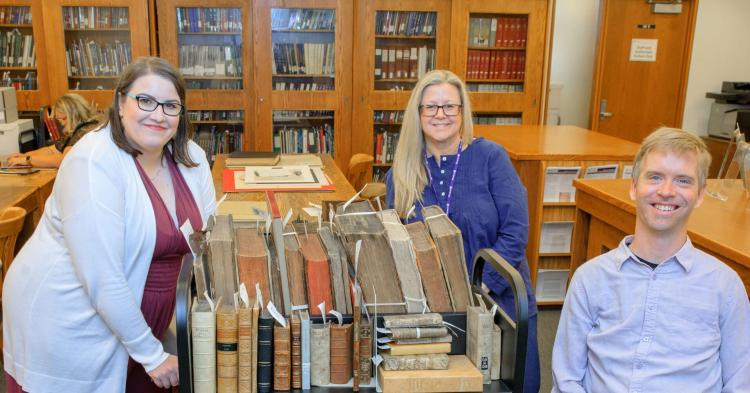
Fourth-year classical studies student Stephanie Leith (left) spent her summer searching for medieval manuscript fragments used to support spines and reinforce bindings in the production of the world's first books. She worked under the guidance of special collections librarian Deborah Meert-Williston (centre) and her research supervisor, classics professor Kyle Gervais (right). (Christopher Kindratsky/Western Communications)
She once worked in the high-tech world for search engine giant Google. Now, Stephanie Leith is manually searching early print books, looking to uncover even older works within.
Leith's quest started this past summer, delving into volumes housed in the Archives and Special Collections (ASC) of Western Libraries, hunting for fragments of medieval manuscripts, once used to make bindings of the world's first books.
As bindings and covers fall away over time, the fragments of parchment become visible. Because the text of these fragments was not typically erased before being re-purposed for bookbinding, it's often possible to read and analyze that text. Researchers can sometimes identify the work from which it was drawn and determine the approximate date of when the manuscript was first produced.
"These fragments offer a window into the past, telling us more about what life was like in a given time," said Leith, who took on the project through Western's undergraduate student research internship (USRI) program.
The opportunity brought the fourth-year classical studies student the satisfaction she was seeking when she left her career and returned to school.
"I was driven by a need and thirst for meaning and to contribute to something larger than myself, which is how I see academia," Leith said. "Now I'm contributing to a piece in the giant puzzle of history."
'Research opportunity too exciting to let go'
Leith first learned of the use of early medieval manuscripts in the art of bookbinding as part of classics professor Kyle Gervais' Introduction to Medieval Manuscripts course, during a class visit to the ASC.
"As we shifted from medieval manuscripts on parchment to print books, manuscripts became old tech' as printing could ramp up the dissemination of written works faster," Leith said.
"Manuscripts weren't thought to be exciting anymore and were often cut into strips to support the spines of books, reinforcing the sewing supports to make sure the books would still open nicely."
As special collections librarian Deborah Meert-Williston showed examples of fragments found in some of the ASC's rare books, Leith became fascinated, eager to learn more.
"Western Libraries had already identified fragments dating back to the early 12th century, and the possibility of finding more was too exciting to let go. When Dr. Gervais pitched the USRI project to me, I absolutely knew that's how I wanted to spend my summer," Leith said.
Under the supervision of Gervais, whose research interests include digital humanities and the study of pre-modern manuscripts, and with the guidance of Meert-Williston, an expert on rare books and medieval manuscript materials, Leith reviewed 200 early books from the 16th century.
She discovered 16 books containing 62 individual fragments, which she photographed, catalogued and recorded. She also created a website to document her findings.
"These fragments were once seen as trash, but for us, they're treasures. There's a whole hidden world of fragments between the covers, beneath the spines of these books, giving us an intricate view of the evolution of human thought and experiences."-Stephanie Leith, fourth-year classical studies student and 2024 undergraduate student research intern
Fascinating findings buried in bindings
The limp parchment bindings of 12 out of the 16 books show they've remained untouched for almost 500 years. The fragments predominantly feature texts written in Latin, with two in Dutch and Hebrew. Others, not yet identified, could be in German or Middle English.
The manuscript fragments vary in size and content, falling in four categories: Christian theology, history of medicine, classical history and English literature.
Highlights include three large fragments from the 13th century decretals of Pope Gregory IX, created to organize and clarify the laws of the Roman Catholic Church.
They hold what Leith calls the "little gem" of her discoveries.
It's not just the main text that's intriguing, but the commentary surrounding it.
"You can see two different people had used it for study. Their handwritten notes are around it and they've done a medieval version of highlighting,' where they draw a little finger to point out what's important. This is an example of how these tiny fragments tell their own story. Those students, through their notes, are showing this was important enough to be studied, how it was interpreted and what it meant to them at the time."
A small 1562 edition of The Epistles of St. Ignatius of Antioch contained not one, but three different fragments.
Gervais identified one of the fragments to be from Julius Caesar's De Bello Civilii 2.4. Hidden' on the spine of the book, it was only found because the book fell apart.
"To discover a pagan work supporting the spine of a Christian one is fascinating," said Leith, who's also pursuing a major in Catholic studies. "In the medieval period, Christianity became dominant, prompting an ongoing debate about classical works the idea they were valuable, but how could Christians reconcile that if pagans wrote them? Finding writings of Julius Caesar under a religious book shows someone found enough value in it to save it, even if they later turned it into trash. It also tells us they were reading Caesar's works and that Caesar's works were being reproduced into the 13th and 14th century."
Relevance of research at Western and beyond
Meert-Williston said Leith's research is helping advance important work for the ASC and Western.
"Although we knew that our early print collection contained manuscript waste', so far there has not been a systematic approach to gathering the fragments all together and creating a record of what we have. Most of the fragments Stephanie identified have not been studied and some of what she uncovered was being seen for the first time in hundreds of years," Meert-Williston said.
She also noted the relevance Leith's and Gervais' ongoing research has beyond Western.
"There is great interest in our medieval manuscript collection, not just from our campus community, but from around the world. Finding, identifying, and describing these fragments is an extremely worthwhile effort because it adds to the quantity and quality of our existing collection, which supports both teaching and research," said Meert-Williston. "Since each medieval manuscript is a unique object, and may contain information not available anywhere else, every fragment offers the academic community the possibility of learning something about the world we didn't know before."
Gervais said the discoveries help give humanities students direct connections to the materials they're studying, a rarity in the field.
"For the classics of Ancient Greece and Rome, the texts we study are here thanks to copies handwritten over time. We have all these fragments, thanks to the fact somebody had an old book kicking around. They no longer saw it as valuable and cut it up to support a new book they did value. Five hundred years later, it is suddenly significant to us, because it's preserving a document hundreds of years older than the book we're looking at."
Preservation, Gervais added, is another important aspect of the manuscript fragment project.
Libraries around the world, including Western, are preserving fragments of ancient medieval manuscripts within early modern books, without knowing they are there. That puts the fragments at risk, often when someone has good intentions of repairing them.
"When a rare book is recovered and rebound, all of this, waste' gets thrown away," Gervais said. "That's why it's important to find it, catalog and preserve it."
Next steps
Fuelled by the findings of her summer internship, Leith is continuing to work on the project with Gervais.
"It's become a bit of an obsession, like solving a mystery," she said. "And there's so much more to explore."
Once Leith finishes studying books in the ASC's 16th century collection, she'll turn her focus to those from the 17th century.
Other next steps include developing a fragment catalogue for Western Libraries and sharing that data on Fragmentarium, a digital laboratory cataloguing medieval manuscript fragments from around the world. This opens the possibility of collaborating with scholars around the world to piece together a manuscript, once cut into pieces and scattered across the globe.
That would be "a gift," for Leith, who's glad to have transferred her love for sharing knowledge at Google to sharing knowledge through tiny pieces of history.
"Working in tech, everything phases out approximately every six months, because things iterate so fast," she said. "What's fascinating about this work is its enduring nature. It's a little footprint in the path of time and part of my footprint now."













